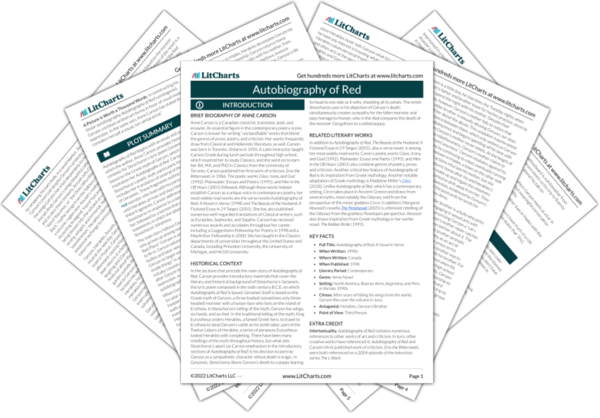Identity and Creativity
As its title suggests, Autobiography of Red is a book that deals with the formation of identity. Geryon, the protagonist, begins constructing his autobiography even before he learns to write, fashioning a sculpture out of a cigarette glued to a tomato in an attempt at self-expression. As Geryon grows older, his preferred tool for creative self-expression becomes a camera, and his autobiography takes the form of a photographic essay. Geryon’s ongoing attempts at identity…
read analysis of Identity and CreativityCommunication and Mystery
Many of the tragedies of Geryon’s life revolve around misunderstandings and failures to connect with others. When Geryon is a young child, his older brother sexually abuses him, threatening him if he says anything to their mother. Because of this forced inability to communicate to Geryon’s mother and his mother’s failure to listen for signs of abuse, Geryon’s brother is allowed to continue this abusive behavior. The trauma of this experience, in turn, instills…
read analysis of Communication and MysteryTime
“What is time made of?” is Geryon’s favorite question. The yellowbeard, a philosopher Geryon meets on a trip to Buenos Aires, offers the unsatisfying answer that time is an “abstraction” that humans “impose upon motion.” Implicit in such a view is that humans construct the idea of time to measure and “impose” structure onto the trajectory of their lives, which otherwise is beyond their ability to control. In quantifying the passage of time…
read analysis of Time
Self and World
One of the central conflicts of Autobiography of Red is Geryon’s quest for individual freedom. He is keenly aware of the fact that “there is no person without a world,” and this statement ultimately becomes his—and the book’s—thesis on how to navigate the larger world as a free individual. As a young child, Geryon fixates on the notion of “inside” versus “outside,” particularly after his older brother sexually assaults him. He learns that while…
read analysis of Self and World






